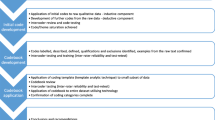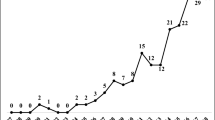Abstract
A program can be analyzed and studied by dividing it into elements and subelements. Graphical presentation of the driver power and dependence of the subelements of the identified elements assists in their classification in categories representing the nature of the role each subelement plays as a variable in the program. This paper presents methodology for the hierarchy building of subelements, graphical presentation of their driver power and dependence, and classification in categories such as autonomous, dependent, linkages, and independent variables. The paper further presents a case study of energy conservation in the Indian cement industry to determine the hierarchy of program plan elements and to classify them in categories. Key variables of the program are also highlighted.
Similar content being viewed by others
References
Godet, M. (1985).Scenarios and Strategic Management, Economic Press, Paris, pp. 44–45.
Harary, F., Norman, R. Z., and Cartwright, D. (1965).Structural Model: An Introduction to the Theory of Directed Graphs, Wiley, New York.
Hawtarone R. W., and Sage, A. P. (1975). On applications of interpretive structural modeling to higher education program planning.Socio. Econ. Plan. Sci. 9, 31–43.
Hill, J. D., and Warfield, J. N. (1972). Unified program planning.IEEE Trans. Syst. Man. Cybern. SMC-2(5), 610–621.
Jedlicka, A., and Mayer, R. (1980). Interpretive structural modeling cross cultural uses.IEEE Trans. Syst. Man. Cybern. SMC-10(1), 49–51.
Malone, D. W. (1975). An introduction to the application of interpretive structural modeling.Proc. IEEE 63(3), 397–404.
Ochuchi, A., Kurihara, M., and Kaji, I. (1986). Implication theory and algorithm for reachability matrix model.IEEE Trans. Syst. Man. Cybern. SMC-16(4), 610–616.
Sage, A. P. (1977). Interpretive structural modeling. InMethodology for Large Scale System, McGraw-Hill, New York, pp. 91–164.
Saxena, J. P., Vrat, P., and Sushil (1989). Energy conservation in Indian cement industry-An application of program planning linkage approach.9th MIAMI International Congress on Energy and Environment, 11–13 Dec,
Saxena, J. P., Vrat, P., and Sushil (1990a). Linkages of key elements in fuzzy program planning.Syst. Res. 7(3) 147–158.
Saxena, J. P., Sushil, and Vrat, P. (1990b). Fuzzy interpretive structural modeling applied to energy conservation (submitted for publication).
Saxena, J. P., Sushil, and Vrat, P. (1990c). Impact of indirect relationships in classification of variables-a MICMAC analysis for energy conservation.Syst. Res. 7(4), 245–253.
Waller, R. J. (1980). Contextual relations and mathematical relations in interpretive structural modeling.IEEE Trans. Syst. Man. Cybern. SMC-10(3), 143–145.
Warfield, J. N. (1971). The DELTA chart-a method for R&D project portrayal.IEEE Trans. Eng. Manage., 132–139 (Correction, May 1972, p. 74).
Warfield, J. N. (1972). Intent structures.IEEE Trans. Syst. Man. Cybern. SMC-3(2), 133–140.
Warfield, J. N. (1973a). Binary matrices in system modeling.IEEE Trans. Syst. Man. Cybern. SMC-3, 441–449.
Warfield, J. N. (1973b). An assault on complexity. Battelle Monograph, 3, Battelle Memorial Institute, Columbus, Ohio.
Warfield, J. N. (1974). Structuring complex systems, Battelle Monograph, 4, Battelle Memorial Institute, Columbus, Ohio.
Author information
Authors and Affiliations
Rights and permissions
About this article
Cite this article
Saxena, J.P., Sushil & Vrat, P. Hierarchy and classification of program plan elements using interpretive structural modeling: A case study of energy conservation in the Indian cement industry. Systems Practice 5, 651–670 (1992). https://doi.org/10.1007/BF01083616
Issue Date:
DOI: https://doi.org/10.1007/BF01083616




